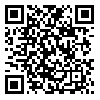Sun, Apr 27, 2025
[Archive]
Volume 9, Issue 1 (March 2013)
IJEEE 2013, 9(1): 1-12 |
Back to browse issues page
Download citation:
BibTeX | RIS | EndNote | Medlars | ProCite | Reference Manager | RefWorks
Send citation to:



BibTeX | RIS | EndNote | Medlars | ProCite | Reference Manager | RefWorks
Send citation to:
Ghavami S, Abolhassani B. Performance Analysis of ZF Pre-Coder and Extended Joint Channel Estimation Method in Downlink CDMA with HPA . IJEEE 2013; 9 (1) :1-12
URL: http://ijeee.iust.ac.ir/article-1-514-en.html
URL: http://ijeee.iust.ac.ir/article-1-514-en.html
Abstract: (7522 Views)
In the down link scenario of code division multiple access (CDMA) systems, multi user detectors (MUDs) such as linear de-correlating detector (LDDs) provide satisfactory symbol error rates (SERs) at the expense of much increased complexity, they require all active users’ spreading sequences, which is impractical from privacy point of view. To overcome this impracticality, a simple matched filter receiver is considered in this paper, which requires no knowledge of co-users’ spreading sequences. However, this simple receiver degrades the SER due to multiple access interference (MAI). To overcome this SER degradation, a zero force (ZF) pre-coder is employed in the transmitter traditionally. Moreover, a composite of CDMA signals has a large peak to average power ratio (PAPR), which causes nonlinear distortion (NLD) at the output of the base station high power amplifier (HPA). This also results in degrading the SER. We analyze the down link scenario of CDMA system to derive an equation for the SER of system with ZF-pre-coder plus HPA in the transmitter and matched filter in the receiver over two cases: additive white Gaussian noise (AWGN) and AWGN plus flat fading channels. Theoretical analysis and numerical results show that the ZF pre-coder increases the total degradation of the link significantly compared with that of the LDD. So, as a solution, rather than using ZF pre-coder, we propose a new method which is called extended joint channel estimation method, it is based on joint estimation of channel gains and LDD operator by the mobile station (MS). In that base station (BS) transmits the row k of LDD operator to the MS k. Simulation results show that the SER of this new proposed method is matched to that of LDD in AWGN channel when the number of pilot symbol repetition is equal to 8. Moreover, this method has the two added advantages of no need for providing the spreading sequences of all co-users and meeting a satisfactory total degradation. Furthermore, our analysis shows that loss in spectral efficiency due to transmitting the pilot symbols in the proposed method is negligible for the practical values of traffic variations.
Type of Study: Research Paper |
Subject:
Radio Communications
Received: 2012/07/10 | Revised: 2013/07/07 | Accepted: 2013/07/07
Received: 2012/07/10 | Revised: 2013/07/07 | Accepted: 2013/07/07
| Rights and permissions | |
 |
This work is licensed under a Creative Commons Attribution-NonCommercial 4.0 International License. |







